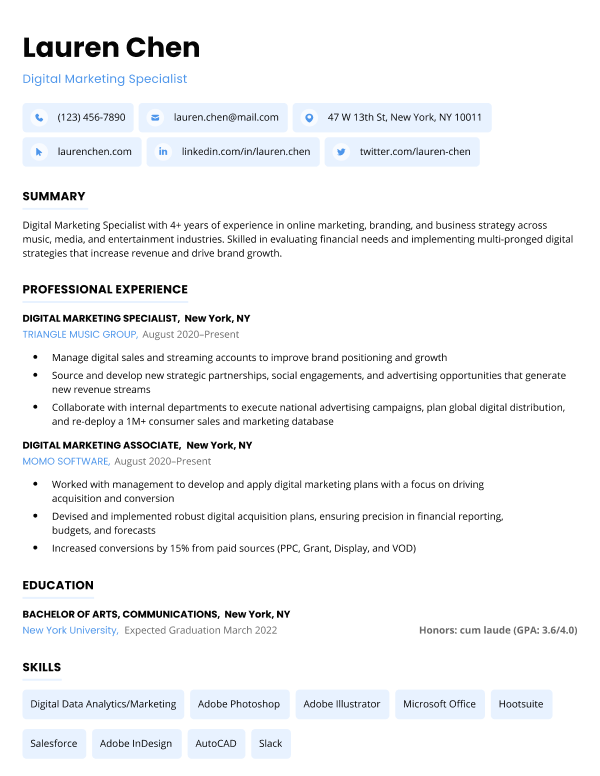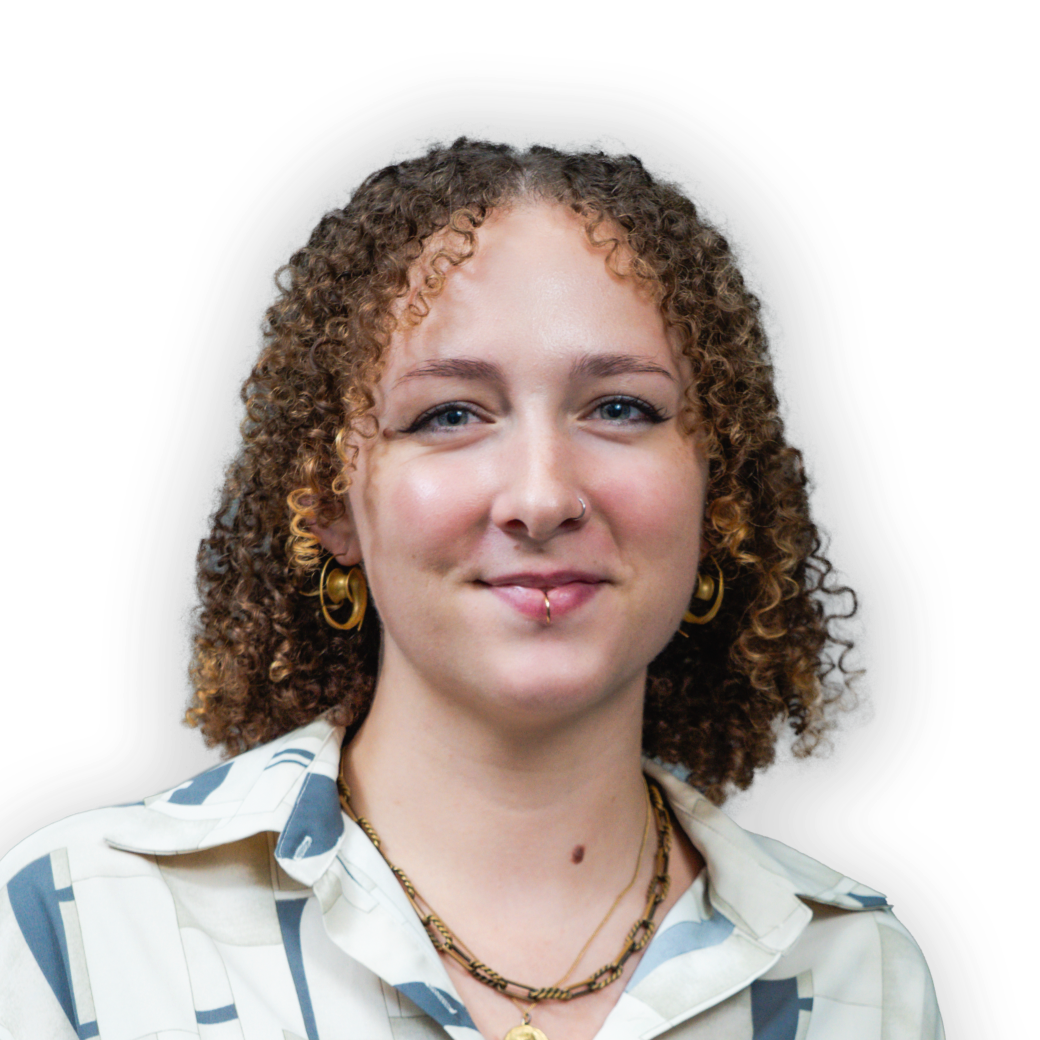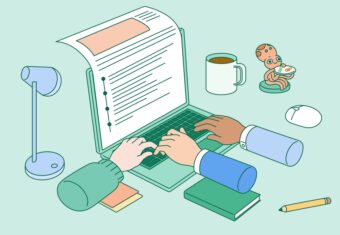Your resume layout is the way you organize the information in your resume, including the order of each section and the general information that you put in each of those sections — from your work history to your education.
Before we dive into how to lay out your resume, here are a couple resources to help make setting up your resume easier:
Our free-to-use resume builder can make you a resume in as little as 5 minutes. Just pick the template you want, and our software will format everything for you.
Here are four different resume layout ideas to help get you inspired:
Simple resume layout
A basic resume layout like this is perfect for anyone who wants to put together a clean, formal application.The classic font, dark color scheme, and straightforward design make this resume a great choice for formal industries like finance and law.
Professional resume layout
With its blue header and clean font choice, this resume layout embodies professionalism.Additionally, a sidebar for contact details and skills makes this layout highly efficient — perfect for candidates with a lot of work experience.
This design is ideal for those looking for work in marketing or sales.
Creative resume layout
Colorful and unique, this resume layout is perfect for any candidate that wants to stand out and show off their sense of style. If you work in a creative industry, this format will work well for you.Modern resume layout
Featuring a timeline structure and a striking black header, this resume layout balances stylish modernism with traditional formality. This layout is great for anyone who wants to give their resume a sleek, contemporary look.
Resume examples for different industries
Not sure what your resume should look like? The best way to learn is by taking inspiration from resume examples written by other candidates in your industry.
The best resume layout for most job seekers
Here’s a basic layout of a resume that’s good for most job seekers, no matter how many years of experience you have.
This resume layout breaks down each part of a resume and explains exactly what details you need to include and where. Simply copy and paste the text into Google Docs or Microsoft Word, and fill it in with your information for a standard yet effective resume.
1. Resume Heading
FIRST AND LAST NAME
Email: youremail@gmail.com | Phone: 895 555 555 | Address: 4397 Aaron Smith Drive Harrisburg, PA 17101 | Linkedin: linkedin.com/in/yourprofile
2. Resume Introduction
Passionate [industry] professional with [# of years] years of experience. Seeking to leverage my expertise in [relevant skills] to fill the [position name] position at [Company’s Name]. A dedicated professional looking to further my career in [industry] and help contribute to [Company’s Name]’s goals as soon as possible.
3. Work or Relevant Experience
Most Recent Job Title
Employer Name / Location / Start Date – End Date
- Include a bulleted list of your accomplishments and responsibilities
- Unless this is the only job you’ve held, use five bullet points or fewer
- Add numbers (such as percentages or dollar amounts) to these bullet points to showcase your specific achievements
Earlier Job Title
Employer Name / Location / Start Date – End Date
- List relevant accomplishments or responsibilities from an earlier job
- If you no longer hold this job, use past tense verbs to describe your achievements
4. Education
Degree Name / Major
University, Location | Start Date – End Date
5. Skills and Certifications
- List your relevant professional skills
- Include a range of hard skills and soft skills
- Be as specific as possible and mention the names of software or tools you can use
6. Additional Resume Section
- Here’s where you can add any other helpful information to your resume
- For example, this section could be for any of the following: awards, languages, volunteer experience, or even hobbies
How to choose the right layout for your resume
While the resume layout above might be great for the majority of job seekers, it’s not the only way to set up your resume. If you’ve had an unconventional career or inconsistent work history, you should look further to find the best resume layout for your background.
With that in mind, there are three different resume layouts commonly used by job seekers: the chronological resume, functional resume, and combination resume (otherwise known as a hybrid resume).
Each layout is designed to emphasize different sections of your resume with the goal of highlighting your main professional strengths.

Chronological Resume Layout
The chronological resume is the most common resume layout, and is appropriate for people at any stage in their career. The key feature of this layout style is that it lists each job you’ve held in the order in which you’ve held it, with the most recent position at the top.
In most cases, the chronological resume layout is the clearest way to organize your qualifications for employers because your work experience section is generally what they care about most when reviewing your resume. However, if you have gaps in your work history, then a chronological resume may not be the best option.
Here’s an example of a resume using a chronological layout:

Functional Resume Layout
The functional resume layout (also called a skills-based resume) focuses primarily on your relevant job skills rather than each job you’ve held and when you held it.
The biggest difference between a functional resume and a chronological resume is that a functional resume features a detailed skills section and groups your experience under skill categories instead of job titles. Under each category, bullet points are used to highlight examples of how you used your skills to accomplish something in the workplace.
This makes the functional resume layout ideal for candidates who have gaps in their work history or are in the process of changing careers.
Here’s an example of a resume that uses a functional layout:

Combination Resume Layout
Combination resumes blend parts of both chronological and functional resume layouts by leading with a detailed skills section, and ending with a strong work experience section.
This makes the combination resume an ideal choice for highly qualified candidates with years of experience, because it allows them to include a high volume of information about their qualifications and skills.
Here’s an example of a resume that employs a combination layout:

How to structure your resume
Now that you know the best layout to use for your own resume, here are some basic formatting rules to help you make yours look professional.
Alternatively, you can save time by using an online resume builder that sets up your resume layout for you.
Set your margins to .63″ by 1″
The ideal margins for a resume are 0.63” on the left/right and 1” on the top and bottom. This combination hits a balance between including as much information on the page as possible while still ensuring your resume is easy to read.
If you’re concerned about not being able to fit your resume onto one page (or if there’s too little information on your resume), consider adjusting your margins as necessary. However, don’t change them too much, or you risk making your resume look too empty or hard to read.
Use a professional font
The best fonts for your resume are easy to read and formal. In most cases, it’s best to stick to classics like Times New Roman, Arial, or Georgia. Whatever font you choose, just make sure it’s not overly stylized so employers can scan your resume easily.
Additionally, the body font on your resume should be no smaller than 10.5 points and no larger than 12. The section headers can be roughly 13-14 points.
Left-align your content
In general, you should keep everything in your resume layout left-aligned. The only exception is your header details, which can be center-aligned if you prefer. Left-aligning the majority of your content ensures that it’s easy for hiring managers to read.
Keep your resume to one page
A one page resume is enough space to communicate all your relevant qualifications without making your resume too lengthy. Additionally, employers generally prefer single page resumes because they’re easier to scan.
However, if you have more than 10 years of relevant work experience, then a two page resume (or sometimes longer) is acceptable.
Build your resume in minutes
Use an AI-powered resume builder and have your resume done in 10 minutes. Just select your template and our software will guide you through the process.
Click to rate this article
4.6 Average rating




















